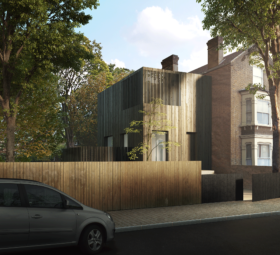
21st-22nd February 2026 - time to get your dream home started!
BOOK HERE
21st-22nd February 2026 - time to get your dream home started!
BOOK HEREMany people would like to live by the sea or a river, attracted by the scenic views and nearby opportunities for boating, fishing and walking.
However, one downside to residing in these locations is the threat of water ingress. Some of the UK’s most picturesque towns and villages have appeared on the news as possessions are lost, homes ruined and lives put in danger by flooding.
And events like this aren’t one-offs, as it looks like the frequency of flooding is set to increase in the coming years due to climate change. This means future dangers have to be considered if you’re planning to self build or extend in an area that’s at risk.
About 5.5 million homes in the UK are in danger of being flooded. That’s approximately 15% of properties built near to rivers, the sea or areas of extreme surface water run-off caused by local ground conditions – the latter of which are often in places that aren’t actually near to open water.
If you’re thinking of self building or altering a house in an area identified as a flood zone then the risks need to be confronted early. This is likely to be an influential issue for your local planning department when they consider your application, and failure to comply with the stipulations of the Environment Agency usually results in a refusal.
There are ways of addressing the concerns of planners, especially if you’re extending a house in a lower risk area. In these cases, keeping the floor level the same as the existing building and including measures that will minimise potential water damage to the structure should suffice.
Getting approval for a completely new house, however, can be more challenging. As well as tackling the risk of the building flooding in the design, you may also have to prove that the local flood plain will not be compromised by the new property.
These are areas of land that are designed to collect floodwater and prevent it from flowing onto higher ground, and their storage capacity can be reduced if they’re heavily developed and covered in buildings.
If you can gain planning permission and are able to buy adequate insurance to build in a flood risk zone, there are two steps to tackling the problem. Firstly, work to prevent the water from entering the house and, secondly, minimise any resulting damage if it does. Experts call these flood resistance and resilience, and the measures taken are known as water exclusion and entry strategies.
The Association of British Insurers says that protecting a house against shallow flash floods costs around £2,000-£6,000, but keeping water out during prolonged flooding requires more work and can come in between £20,000 and £40,000. If you can afford it, resistance and water exclusion are the best long-term strategies.
Read more: Choosing the right site insurance
Fitting an early warning system in the form of a sensor and alarm is a sensible precaution. Preferably, these should be positioned outside at a lower level than the ground floor. They work to alert you if a flood is expected, thus giving you enough time to put temporary measures in place and move some possessions upstairs. But, obviously, you’ll need to be in the house at the time for this to work.
The simplest water exclusion measure is to build the ground floor above the maximum level that any flood water is likely to reach. However, this is often impractical and planners may not approve of the building being disproportionately higher than neighbouring properties.
Where the potential flood level is below 600mm, there are a number of relatively simple ways of sealing off the inside and keeping a new house more or less dry. A common option is to use tanking; a continuous waterproof layer buried within the wall and floor construction that prevents floodwater from seeping into rooms.
However, there are still plenty of routes for water to get in, not least through a home’s doors and windows. Fenestration can be sealed at a low level using hinged flood barriers that can be quickly swung or slotted in place in the event of a flood warning.
Categorising flood riskThere’s a scale of three categories that identify if an area is at risk of flooding, where a higher number shows a greater level of danger: Flood zone 1: These areas are considered to be at very low risk, with less than a 1 in 1,000 chance of flooding. There aren’t many planning restrictions here, except for in the case of large developments. Flood zone 2: There’s a moderate chance of flooding here; annual probabilities are between 1:1,000 and 1:100. The local planners will ask for a flood risk assessment (known as a flood consequence assessment in Wales) which usually means you’ll have to commission a report. The results will analyse the risks, indicate the impact of the new building on potential flooding and identify the ways that the threat will be tackled in the design. Flood zone 3: This means the area is at a high risk of flooding – a chance of 1:100 near rivers and 1:200 by the sea. Planning applications in these zones need a more detailed assessment. Local authorities have their own subdivision of this category into 3a and 3b. The latter identifies a 1:20 possibility, so the restrictions on new development are the most stringent. |
Airbricks are potentially vulnerable, but they can be fitted with temporary covers, automatic seals that drop into place, or permanent snorkels that will allow air to flow via an outlet at a higher level.
One of the most unpleasant side effects of a flood is the potential release and circulation of raw sewage inside the house; this can be avoided by fitting non-return valves to
all the drainage routes.
Like many of these preventative measures, this is a simple DIY job provided the drains are easily accessible by manholes. All potential entry points via service pipes below the flood level have to be checked and tightly sealed. Bear in mind that electricity and water are not a good mix, so external meters will need to have the protection of waterproof cabinets.
Where the flood level could reach above 600mm, it’s more difficult to provide effective protection because the deeper the water, the more forceful the pressure pushing onto the property. Windows and doors can be specially reinforced using strong materials and seals, but even these have height limitations above which they will fail.
Another more extreme solution is to construct the house on stilts, lifting it above the predicted flood level. A recent innovation is to make the stilts extendable to allow the house to rise and float when the water is high, dropping back down as it recedes. This technique has been very successful in other countries, such as Holland, but it hasn’t been used on many new houses in the UK.
If future flooding is inevitable, the building should be designed in a way that minimises internal damage and allows floodwater to leave as quickly as possible once it has receded. There is a contradiction here, because if the water drains out easily it can probably get in just as quickly, so you have to research the likely maximum flood levels before deciding which strategy to adopt.
Engineering bricks are not the most attractive cladding for a house and aren’t good insulators, but do have the advantage of being very resistant to water penetration. They also won’t be much affected if they get wet, so are very useful for masonry construction up to the flood level. For cavity wall builds, you should ensure there are weepholes at the lowest points to allow water to drain out.
It’s best to avoid timber joists and boards on the ground floor because they will expand, twist and even rot as they get wet. A suitable wooden board will be marked as WPB (weather and boil proof) grade, designed to resist wet conditions. It’s best to avoid timber on window and door frames in areas at risk of flooding, as well.
Suspended concrete floors may seem like a good idea, but the void beneath them takes a long time to drain away unless there is a pump (an alternative is for the ground to slope down to a low point where a hatch can be opened to allow a free flow out). Ground bearing concrete slabs are the best choice for avoiding these problems.
Floor insulation should be of the closed cell type, which won’t absorb water – however, be aware that if it’s installed near the top of the construction, there is a risk it will float and even lift a concrete screed level above it.
Choose fixtures, fittings and finishes based on their impermeability; for instance, avoid fitted carpets and opt for tiles with waterproof grout instead, perhaps made a little warmer by rugs that can be taken upstairs if needed.
It’s also worth installing waterproof skirtings. A dado rail can divide lower level plasterboard cladding from the higher level, to reduce any post-flood replacement work. The Building Regulations already require plugs and sockets to be at a high level in any new rooms, and this should be followed through for existing ones, too.
Kitchens can be expensive to be flood proof. This is generally done by choosing plastic or stainless steel units (the latter is the best option). Also look to have all electrical appliances mounted at a high level.
An alternative strategy when specifying materials is to choose ones that you wouldn’t mind replacing in the event of a flood. In other words, buy cheap products, such as a timber-effect floor laminate, allow the damage to happen and then install something new afterwards.
Because there is such a shortage of suitable self build sites in the UK, you may find that taking on a project in a flood zone is the best option. But if you do then be prepared to work hard to justify the planning proposal and make sure you factor in the extra costs that result from protecting the new house against the worst happening.
Top image: Backwater, a self build on the banks of the Norfolk Broads, won the 2017 RIBA East Award. Read more
